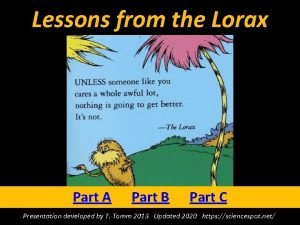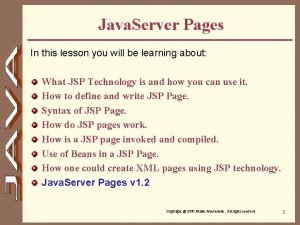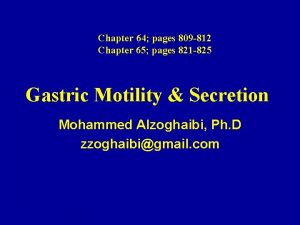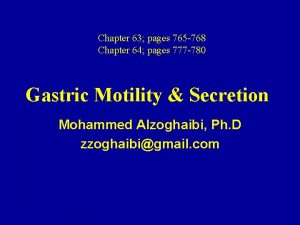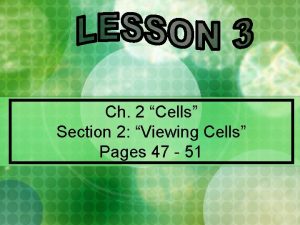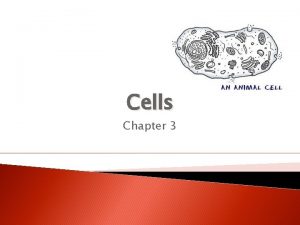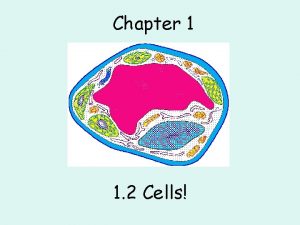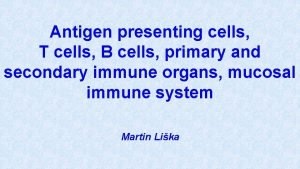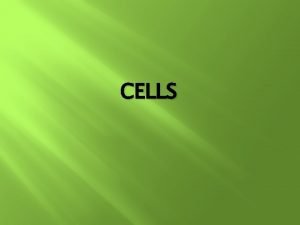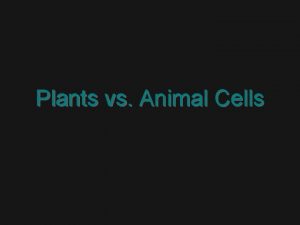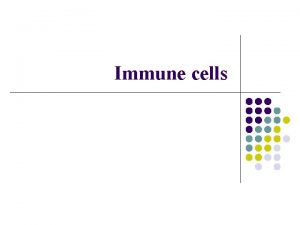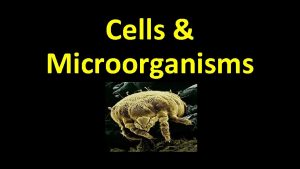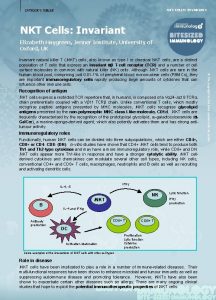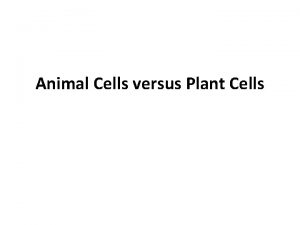Cells Pages 29 49 Chapter 3 v Cells



























- Slides: 27

Cells Pages 29 – 49 Chapter 3

v Cells Page 30 = the basic unit of structure & function of all living things v Our bodies are made up of trillions of cells that live mostly for a few weeks or moths, die, & are replaced by new cells.

Page 30 v Protoplasm Cells are composed: • Protoplasm = an aqueous solution of carbohydrates, proteins, lipids, nucleic acids, & inorganic salts surrounded by a cell membrane. • Organelles = structures that have a specific function in the cell ü Mitochondria ü Nucleus ü Ribosomes ü Lysosomes ü Centrosomes ü Peroxisomes ü Centrioles ü The Golgi ü Endoplasmic apparatus reticulum ü cytoskeleton

Page 30 Cell/Plasma Membrane v Cell membrane (plasma membrane/semipermeable membrane) = surrounds the cell & separates it from the external environment & from neighboring cells. v It also regulates the passage or transport of certain molecules into & out of the cell, while preventing the passage of others. v Its composed of a double phospholipid layer, with proteins embedded in the layer. v Phospholipid layer looks like balloon with tails

Page 30 Nucleus v Nucleus = Most important organelle within the cell, usually located in the center of the cell, spherical in shape with a nucleus membrane surrounding it. Contains DNA & chromatin • Function: ü Control the activities of the cell ü Facilitate cell division v Chromosomes = chromatin condensed to form short rod-like structures. (only happens during mitosis & these are visible on a microscope)

Page 31 – 32 Functions of Organelles Nuclear membrane (nuclear envelope) = Regulates transport of substances into & out of the cell v Nucleoplasm = A clear, semi-liquid medium that fills the spaces around the chromatin & the nucleoli v Nucleolus = Reservoir for RNA v Ribosomes = Serve as site for protein synthesis v Cytoplasm = Provides an organized watery environment where life functions take place via the activities of the organelles, which reside there v

Page 32 – 33 Functions of Organelles v v Centrosome = Contains two centrioles that are functional during animal cell division Endoplasmic reticulum = Provides passage for the transport of substances in the cytoplasm v Mitochondria = Serve as sites of cellular respiration & energy production; Store ATP v Golgi apparatus = Manufactures carbohydrates & packages secretions for discharge from the cell

Page 33 – 34 Functions of Organelles v Lysosomes = Serve as center for cellular digestion v Perioxisomes = Enzymes that oxidize cell substances v Cytoskeleton = Forms internal framework v Pinocytic vesicles = Provide mechanism by which large molecules can enter the cell v Cilia & flagella = Create movement

Page 34 Cellular Metabolism v Chemical v Energy v ATP reactions occur within the cells supplied by ATP created from carbohydrates, proteins, & fats that we eat

Page 34 Cell Division v v Meiosis • Involves reproduction • Each daughter cell carries only half of the chromosomes (23) Mitosis • Involves growth & maintenance of cells • Each daughter cell carries the complete set of chromosomes (46)

Page 34 v Process Meiosis of cell division of the sex cell or gamete v Ovum & spermatozoa reduce chromosomes from 46 to 23 v Fertilization v Zygote = union of ovum & spermatozoa is formed from two sex cells to obtain full set of 46 chromosomes

Mitosis Page 34 Two distinct processes of cell division: • Division of the nucleus • Division of the cytoplasm v Mitosis essentially is an orderly series of steps by which the DNA in the nucleus or the cell is equally distributed to two daughter, or identical, nuclei. During the process, the nuclear material is distributed to each of the two nuclei. This followed by the division of the cytoplasm into two approximately equal parts through the formation of a new membrane between the two nuclei. v

Page 35 v Phase Mitosis Stages I – Interphase = (resting stage) refers only to the fact that the cell is not actively undergoing cell division • At the start of mitosis, each chromosome has already replicated. Each strand of the replicated chromosome is called a chromatid. The two chromatid strands are joined by a small structure called the centromere. During interphase, two centrioles located near the periphery of the nucleus are quite visible. The two centrioles are found in an area called the centrosome.

Pages 35 – 36 Mitosis Stages (Cont’d) v Phase II – Prophase = During this phase, the two pairs of centrioles start to separate toward the opposite ends the cell. As the two pairs of centrioles migrate, an array of cytoplasmic microtubules form between them. • There are changes in the nucleus as well. The nuclear membrane starts to dissolve & the nucleus disappears. The DNA in the chromosomes becomes more coiled or condensed & forms very deeply staining, rodlike structures.

Pages 35 – 36 Mitosis Stages (Cont’d) Phase III – Metaphase = the nuclear membrane has dissolved completely. • The chromatid pairs arrange themselves in a single file, one chromatid pair per spindle fiber between the two centrioles The area where the chromatid pairs align is called the equatorial plate. v Phase IV – Anaphase = During this phase the chromatid pairs separate & are pulled by the shortening spindle fibers toward the centrioles. • The two chromatids of each replicated chromosome are now fully separated. v

Page 36 Mitosis Stages (Cont’d) v Phase V – Telophase = During this phase the chromosomes migrate to the opposite poles of the cell. There they start to uncoil to become loosely arranged chromatin granules. The nucleolus granules. The nuclear membrane & the nucleolus reappear to help reestablish the nucleus as a definite organelle again. When the cytoplasmic division is finished, two new daughter cells are formed. v Cycle back to interphase

Page 36 Mitosis Stages

Page 37 Cell Death v Necrosis = the name given to the unprogrammed death of cells & living tissue. v Apoptosis = death that is the predestined fate of individual cells or organisms.

Page 37 v Cells v DNA v RNA Protein Synthesis produce proteins that are essential to life

Page 38 v Embryonic v Adult Stem Cells stem cells v Umbilical v Induced cord blood stem cells pluripotent stem cells

Pages 37 – 40 Movement of Materials Across Cell Membranes v Passive transport = Does not require an energy source • Diffusion = a physical process whereby molecules of gases, liquids, or solid particles spread or scatter themselves evenly through a medium. • Osmosis = the diffusion of water or any other solvent molecule through a selective permeable membrane. • Filtration = the movement of solutes & water across a semipermeable membrane.

Pages 40 – 41 Movement of Materials Across Cell Membranes v Active • • transport = Requires an energy source Phagocytosis = the substances engulfed are within particles Pinocytosis = the substances engulfed by the cell membrane are in solution

Page 42 Figure 3 – 9 The Active Transport Model

Page 41 Specialization v May lose some functions, such as reproduction v Interdependence v Nerve v Red among cells – Specialize in response blood cells – Specialize in oxygen transport

Page 42 Disorders of Cell Structure Atrophy = cells decrease in size usually due to ageing or disease v Hypertrophy = cells increase in size usually due to workload v Hyperplasia = cells increase in number which is related to hormonal stimulation v Metaplasia = cells change into another type of cell this may be a protective response to a stimulus v Dysplasia = change in size, shape, & organization of cells as result to stimulus. Can progress to neoplasia v Neoplasia = changes in cell structure that occur in an uncontrolled growth patterns. v

Pages 43 – 44 v When Tumor cell division does not occur in the usual pattern – also called neoplasms v Benign tumors = composed of cells confined to the local area v Malignant tumors = can spread to other parts of the body through a process called metastasis

v Aging Page 43 is a phase of normal development v Older person may have 30% fewer cells v Cells may change in ability to perform specialized tasks v Physiologic changes are universal and progressive v Aging is not a disease
 Printed pages vs web pages
Printed pages vs web pages Chapter 8 cellular reproduction cells from cells
Chapter 8 cellular reproduction cells from cells Development of paranasal sinuses
Development of paranasal sinuses Dr saja
Dr saja Thyroid gland
Thyroid gland Somatic cells vs gametes
Somatic cells vs gametes Somatic vs germ cells
Somatic vs germ cells Red blood cells and white blood cells difference
Red blood cells and white blood cells difference Eucariote
Eucariote Animal cell venn diagram
Animal cell venn diagram Prokaryotic cells vs eukaryotic cells venn diagram
Prokaryotic cells vs eukaryotic cells venn diagram Why did robert hooke name cells “cells”?
Why did robert hooke name cells “cells”? Masses of cells form and steal nutrients from healthy cells
Masses of cells form and steal nutrients from healthy cells Pseudostratified vs simple columnar
Pseudostratified vs simple columnar What cell type
What cell type Which compares prokaryotes and eukaryotes
Which compares prokaryotes and eukaryotes Cells cells they're made of organelles meme
Cells cells they're made of organelles meme Dominant rules
Dominant rules A website is a collection of web pages
A website is a collection of web pages A tree falls the way it leans quote meaning
A tree falls the way it leans quote meaning Jose pages rebollar
Jose pages rebollar What is jsp file
What is jsp file What symbolic number is engraved on montag's helmet?
What symbolic number is engraved on montag's helmet? Why does montag plant the book at black's house
Why does montag plant the book at black's house Fahrenheit 451 burning
Fahrenheit 451 burning 3 pages double spaced
3 pages double spaced House of leaves footnote 75
House of leaves footnote 75 Fahrenheit 451 pages 93-110 summary
Fahrenheit 451 pages 93-110 summary



















